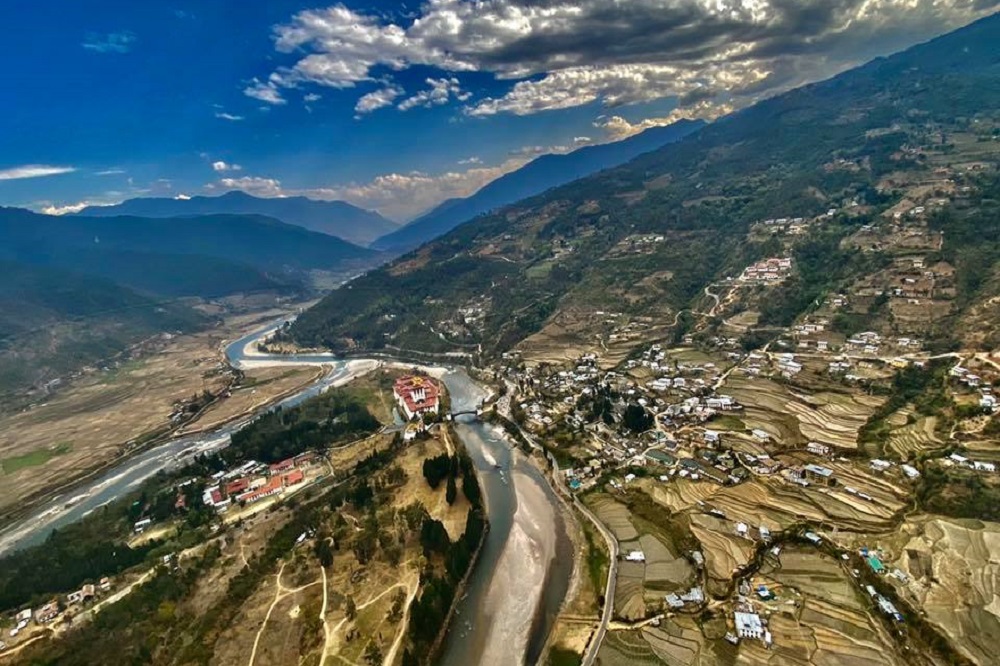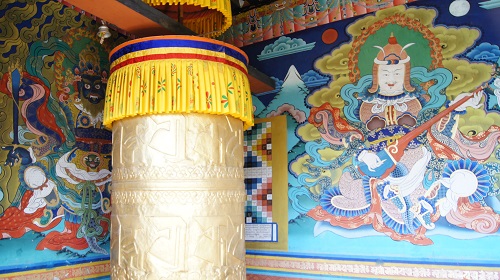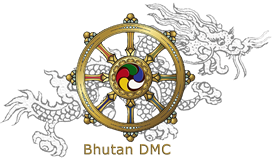Punakha (altitude 1,300m) - Home to the magnificent Punakha Dzong sitting majestically on the confluence of rivers

Punakha served as the capital of Bhutan and seat of government until 1955 and still it is the winter seat of Je Khenpo (the chief abbot). Linked to some of the most momentous events in Bhutanese history, in 1651 Punakha was chosen to be the capital and two and half centuries later, in 1907, Punakha was, again the place where Bhutanese people elected the first King, Gongsar Ugyen Wangchuk. Blessed with temperate climate and owing to its natural drainage from Pho Chhu (male) and Mo Chhu (female) rivers, the fertile Punakha valley produces abundant crops and fruits. Located at an elevation of 1,300m above sea level, Punakha enjoys mild winters and is popular year-round destination. There are splendid views of the distant Himalayas at Dochula pass (alt. 3,080m) on Thimphu – Punakha road.
Places of Tourist Interest in Punakha
Punakha Dzong
Also known as ‘The Palace of Great Bliss’, Punakha Dzong was built strategically at the junction of Pho Chhu and Mo Chhu rivers in 1637 by Zhabdrung Ngawang Namgyal to serve as the religious and administrative centre of the region. The Dzong has played an important role in Bhutan’s history and on 17 December 1907, the first King of Bhutan Gongsar Ugyen Wangchuk, was crowned here. Damaged by six catastrophic fires, an earthquake and once by flood, the Dzong has been fully restored by the fourth King. Dzongchung (or the little Dzong), built in 1328 by saint Ngagi Rinchen can still be seen opposite the main Dzong.
Sangchhen Dorji Lhuendrup Lhakhang Nunnery
Perched on a ridge amid pine trees and overlooking valleys of Punakha and Wangduephodrang gleams Sangchhen Dorji Lhuendrup temple. It houses a 14-foot main bronze statue of Avalokiteshvara and of Guru Padsambhava, Gautam Buddha, Zhabdrung Ngawang Namgyal, Tsela Namsum, the 21 Taras and Tsepamay (Buddha of longevity). The temple complex also houses a permanent higher learning and meditation centre for nuns where, apart from religious training, it provides life skill training such as tailoring, embroidery, statue making and thangkha painting.
Hike and Excursions in and around Punakh
Chimi Lhakhang
The Chimi Lhakhang (temple), situated on a round hillock in the centre of Punakha valley near Lobesa, was built in 1499 by the 14th Drukpa hierarch, Ngawang Choegyel, after the site was blessed by the maverick saint Drukpa Kuenley who in the late 15th century used humour, songs and outrageous behaviour to dramatise his teachings and due to this also known as ‘Divine Madman’.
In regard to this temple site, it is said that Lama Kuenley subdued a demon of Dochu La with his ‘magic thunderbolt of wisdom’ and trapped it in a rock at the temple’s present location The lhakhang is the repository of the original wooden symbol of phallus that Lama Kuenley brought from Tibet. This wooden phallus is decorated with a silver handle and is used to bless people who visit the monastery on pilgrimage, particularly women seeking blessings to beget children. The tradition at the monastery is to strike pilgrims on the head with a 10-inch (25 cm) wooden phallus.
The Lhakhang is situated about 10 km from centre of Punakha town near Sopsokha village, from where a 20-minute walk through fields of mustards and rice, leads to a hillock that is the site of temple. Prayer flags are lined all along the road from the tiny village hamlet known as Yowakha, along a stream to the monastery. All houses in the village are decorated with paintings of phalluses on their exterior walls. The lama Kuenley had called the hillock where the monastery exists as the breast of a woman because of its round shape.
Khamsum yulley Namgyal Chorten
Seven kilometres northeast of Punakha Dzong, the regal Khamsum Yuelley Namgyal Chorten stand 30 metres (100-feet) tall having three stories, covered with painted pageant of characters from the annals of Vajrayana Buddhism. The chorten was built to remove negative forces and promote peace, stability and harmony in the changing world. It dominates the upper Punakha Valley with commanding views across the Mo Chhu and up towards the mountainous peaks of Gasa and beyond.
From vehicle parking lot, a path leads from the roadside to a bridge across the Mo Chhu (river), before climbing steeply up to the chorten. It’s a lovely two hour’s round trip walk enjoying fabulous views up and down the lush Mo Chhu Valley.
Limbukha
Drive to Punakha Dzong and then walk across the suspension bridge (about 200m long) through absolutely fresh breeze and fascinating view of Dzong. Follow the farmhouses gradually climbing towards Dompala hills. The view of Dzong, Pho Chhu, Mo Chhu rivers and surrounding village is superb amidst chirpine forests. The walk is another two and a half hours to Limbukha.
Limbukha farmers grow Bhutan’s famous red rice which is supposed to have medicinal values. This particular rice needs clean mountain spring so that the taste is good and nutritional value maintained. Limbukha is also known for its love of peace and tranquillity. Legends says that during medieval wars the ‘limpus’ or the people of Limbukha always volunteered as peace negotiators. This is also depicted during yearly festival called ‘Serda’ when the men are found carrying peace flags instead of swords and fireworks.
Talo
The village of Talo (alt. 2,800m) which is scattered along the hill slopes, known for its cleanliness and hygiene among Punakha villages. Talo Sangnacholing is built on a plateau and has majestic view of surrounding villages. The beautiful farmhouses of the village have its own flower gardens and on the hill slope corns and sweet peas are grown in abundance. The women of Talo are particular known for their beauty.
HOTELS IN THIMPHU
HOTELS IN PUNAKHA & WANGDUE
HOTELS IN GANGTEY
HOTELS IN TRONGSA
HOTELS IN BUMTHANG
HOTELS IN MONGAR
HOTELS IN TRASHIGANG
HOTELS IN SAMDRUP JONGKHAR
HOTELS IN PHUENTSHOLING
HOTELS IN HAA
HOTELS IN GELEPHU
HOTELS IN ZHEMGANG
RESTAURANTS IN PARO
RESTAURANTS IN THIMPHU
RESTAURANTS IN PUNAKHA
TOUR ITINERARIES
TREKKING ITINERARIES
SPECIAL INTERESTS TOURS
UNIQUE FESTIVALS & FAIRS
BLOG


